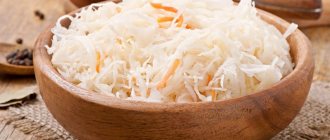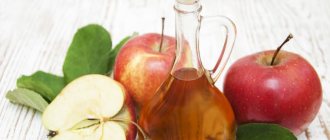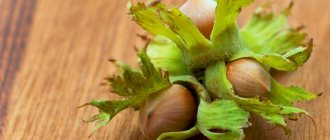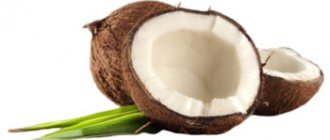Pickling is the most effective way to preserve the beneficial properties of cabbage. That is why we started making such preparations many centuries ago. Sauerkraut not only retains almost all of its vitamins and minerals, but is also enriched with new ones. And its low calorie content makes it very effective for weight loss. This is perhaps the most affordable way to replenish the deficiency of nutrients during the winter. However, this product can be not only useful if you do not take into account restrictions when using it.
Sauerkraut
Composition of the product
The benefits of sauerkraut for the body are explained by the presence of a lot of important elements and vitamins. First of all, it is ascorbic acid, which is necessary for preserving youth and preventing many diseases, including cancer. There is so much vitamin C in sauerkraut that to fill the daily requirement it is enough to eat 200 grams of the product. It is noteworthy that it is presented in sauerkraut not only in free, but also in bound form, like ascorbigen. This substance persists for a long time and releases ascorbic acid when exposed to moderate heat.
Separately, we should also note the very rare vitamin U, of which there are as many as 21 mg per 100 grams. Its benefit to humans lies in the prevention of ulcerative formations on the walls of the digestive organs. Therefore, sauerkraut, despite its acidity, is useful for people suffering from gastroduodenitis, gastric or intestinal ulcers.
We should not forget such valuable resources as vitamin K, inositol and choline, folic and tartronic acid. The concentration of these substances in sauerkraut exceeds similar indicators among many canned and pickled vegetables. It also contains:
- vitamins A, B1, B2, B5, B6, B9, PP, P;
- beta-carotene;
- calcium, magnesium, phosphorus, potassium, sodium;
- iron, fluorine, zinc, iodine, molybdenum, manganese, etc.
Vitamins and minerals included
The vitamins and nutrients are impressive in their diversity. If a fresh head of cabbage is a storehouse of vitamins, then the pickled dish also contains a considerable amount of vitamin C.
Vitamins in the composition (mg/100 g):
- S- 45.2;
- PP- 0.52;
- B1- 0.04;
- B2- 0.02;
- E- 0.18.
Macroelements and microelements are represented by the following substances (mg/100 g):
- potassium - 301;
- sodium - 929;
- calcium-47.9;
- phosphorus - 31.4;
- magnesium - 16;
- iron - 0.6.
The glycemic index of sauerkraut is below the maximum norm, so diabetics can easily afford this delicacy.
For weight loss
The calorie content of sauerkraut is very low - only 27 kcal per 100 grams, of which only 1 kcal comes from fat. For this and a number of other reasons, it is great for weight loss:
- 100 grams contain 20% of the daily intake of dietary fiber, which effectively cleanses the intestines, massages the walls and stimulates blood circulation in the digestive organs.
- The microelement base that enters the human body with pickled leaves improves metabolism, normalizes the functioning of the endocrine system, and accelerates the separation and removal of cholesterol from the blood vessels.
- Eating cabbage promotes the natural process of weight loss - to digest it, the body spends more energy than it receives.
It should be borne in mind that a diet based on sauerkraut is a rather difficult procedure. Reviews from women who have decided to undertake such a test say that during it it is necessary to endure a monotonous diet and a regular feeling of hunger, because this product does not satiate very much, but awakens a noticeable appetite. To lose weight, it is recommended to include cabbage in your general diet, combining it with nutritious foods such as peas or pumpkin.
BJU and calorie content of pickles
The calorie content of sauerkraut is practically no different from fresh vegetables; 100 g contains only 23 calories. Nutritional value is determined by the following BJU indicators (g/100 g):
- proteins - 1.7;
- carbohydrates - 2.9;
- fats - 0.2.
The energy value is supplemented by dietary fiber, which contains a couple of grams, and organic acids, no more than 1 gram.
Benefit
The beneficial properties of sauerkraut have a beneficial effect on many body systems, participating in strengthening, stimulating and regulating work:
- During fermentation, lactic acid bacteria actively multiply in the product, the benefits of which for digestion everyone has heard.
- Repeated studies have confirmed that sauerkraut is a more beneficial product for humans than fresh or prepared in any other way. This is explained by the fact that when boiling and stewing, the vegetable loses some properties and elements, and when fermented, it gains new ones.
- Other vegetables can boast a high content of potassium and iron, but cabbage is a rare specimen in which these elements are bound by vitamin P. Together, these substances strengthen the thinnest and most distant vessels - capillaries, and reduce their permeability. The result is an improved supply of all body tissues through the blood.
- Sauerkraut is enriched with many antioxidants that prevent cancer processes.
- The antiparasitic properties of this dish help expel parasites. The increased effect is noticeable when consumed simultaneously with tomato juice.
- During fermentation, lactic and acetic acid appear in the vegetable leaves and juice. The first is mistaken by doctors as an enemy, allegedly leading to muscle cramps and similar problems. This is not so, lactic acid is necessary for a person to effectively absorb carbohydrates, natural production of glucose and glycogen. And acetic acid improves the transfer of oxygen from the blood to the cells.
- Vitamins and microelements have a complex effect on the nervous system, preventing the occurrence of nervous tension, stress injuries, sleep disorders, and irritability.
- A group of B vitamins in combination with ascorbic acid and antioxidants effectively prevents the aging of skin cells, loss of muscle tone, and strengthens hair, skin and nails.
- Rarely found in foods, tartronic acid is a natural inhibitor of the conversion of carbohydrates into stored fat, which is very important for losing weight and preventing excess weight.
- The ability to stimulate water-electrolyte balance and the high content of vitamin C make it possible to use sauerkraut for hangover syndrome.
Medicinal properties of sauerkraut
All of the above characteristics determine the following properties of the product:
- Prevention of oncology. Scientific research has shown that a seemingly ordinary product is an excellent means of preventing the formation of malignant tumors. It prevents the increase in the number of cancer cells, especially in the intestines, mammary glands and lungs.
- Gastrointestinal tract. Vitamin U in the composition improves digestion, protects the gastric mucosa, and normalizes acidity levels.
- Dietary fiber will help you quickly digest food, and vitamin B6 speeds up the digestion of meat.
- E. coli and dysentery. Lactic acid will help cope with these problems.
- Helminths and Giardia. If you mix the brine with tomato juice in equal proportions and drink it half an hour before meals, you will say goodbye to the problem. If your goal is to improve liver function, then this drink will also help.
- The cardiovascular system. Cholesterol comes back to normal, prevents atherosclerosis, improves heart rhythms. Juice is a long-standing healer for hypertension.
- Increasing resistance to stressful situations.
- The presence of vitamin C strengthens the immune system and helps with vitamin deficiency after a long winter. Relieves the general condition of flu or colds.
- People suffering from diabetes can and should eat sauerkraut, since the product contains a small amount of sugar, and fiber helps reduce its levels.
- Allergy. The delicacy has antihistamine characteristics, and this fact has been confirmed by scientists. Cabbage will help cure allergies and bronchial asthma.
For women
Appetizing crispy sauerkraut is traditionally considered a very valuable product for the health and beauty of women. This is due to the wide range of beneficial properties described above. First of all, of course, the dietary characteristics of sauerkraut matter. Its regular presence in the diet leads to many positive changes:
- the digestive system is cleansed and disinfected;
- blood cholesterol levels decrease;
- metabolic processes are normalized;
- skin and hair become young and healthy.
Cabbage leaves are useful not only for weight loss, but also for pregnant women who help cope with toxicosis. There are also known methods for their cosmetic use:
- to get rid of acne and acne, you need to tightly place chopped sauerkraut pulp on your steamed face and cover with a napkin for half an hour;
- You can make a mask from the brine against age spots and freckles - just put a napkin soaked in it on your face for 10-15 minutes, and then wash your face.
Cabbage in a tub
Brine for maintaining men's health
The remaining juice after eating pickles should not be thrown away. The health benefits of this liquid are great, especially for men.
- Aphrodisiac. A powerful aphrodisiac that will help a man maintain his “fighting efficiency” for many years.
- Hangover cure. For a long time, this unique effect of cabbage juice has been known to everyone. If you drink juice after a heavy meal with a lot of alcohol, your health will improve significantly.
Contraindications
There are always restrictions on consumption, even if we are talking about such a rich product as sauerkraut. Benefits and harms are inseparable, so you shouldn’t abuse it - oversaturation of the body with vitamins and microelements can be no less harmful than a deficiency. Nutritionists and doctors advise not to pounce on a crispy dish with excessive effort, even if you really want to. It is better to gradually introduce it into the diet, allowing the body to get used to it. In some cases, eating sauerkraut requires special caution:
- Firstly, those who suffer from increased stomach acidity due to gastritis or a predisposition to it should limit or completely avoid eating sauerkraut leaves.
- It should be borne in mind that even in a person with healthy digestion, a large amount of cabbage can cause heartburn or flatulence.
- The high salt content in a dish sometimes becomes the reason for a ban on consumption for those who are prone to edema of cardiac origin. Only the attending physician can provide comprehensive information on this matter. Most likely, you will be allowed to eat cabbage, but you will need to rinse it in boiled water before doing so.
- It is also recommended to reduce product consumption to a minimum if there are problems with high blood pressure, diseases and inflammatory processes in the liver and kidneys.
Cabbage for sourdough
Contraindications and possible harm of sauerkraut
The product has minimal contraindications, but please keep them in mind. The product can irritate the gastric mucosa, cause the formation of insidious gases and increase blood pressure. Therefore, those who have:
- have an ulcer or gastritis;
- increased acidity;
- have kidney ailments;
- tendency to edema;
- there are significant problems with the stomach or pancreas;
- high blood pressure (excess sodium causes high blood pressure).
Another product is best not given to children under 3 years of age.
How to choose cabbage
When purchasing a product in a store, you should pay attention to the following indicators:
- Give preference to the white-golden hue of the dish. An overly white product with a sweetish taste indicates improper ripening.
- If possible, smell the snack. Many unscrupulous sellers use vinegar in the cooking process. This makes the salad just as edible, but not nearly as healthy.
- Don't pass by the appetizer, cut into thick slices. In this form, more vitamins are stored.
If you eat healthy, you will maintain your zest for life and good health for a long time. Sauerkraut will help you survive winter vitamin deficiency easily and tasty.
Directions
Sauerkraut
IngredientsDirections
Table 1
| Products | Weight | Squirrels | Fats | Carbohydrates |
| White cabbage | 10 | 0.18 | 0.01 | 0.47 |
| Carrot | 500 gr | 6.5 | 0.5 | 34.5 |
| Salt | 250 gr | 0 | 0 | 0 |
| Granulated sugar | 100 gr | 0 | 0 | 99.8 |
| Exit | 10000 | 6.68 | 0.51 | 134.77 |
Content of chemical elements
Table 3
| Elements | Content | Daily norm |
| Iron (Fe) | 0.11 mg | 0.79 % |
| Iodine (I) | 0.25 mcg | 0.19 % |
| Potassium (K) | 10.56 mg | 0.3 % |
| Calcium (Ca) | 10.63 mg | 1.06 % |
| Magnesium (Mg) | 2.47 mg | 0.62 % |
| Manganese (Mn) | 0.01 mg | 0.51 % |
| Copper (Cu) | 4.08 mcg | 0.41 % |
| Molybdenum (Mo) | 1.01 mcg | 1.44 % |
| Sodium (Na) | 968.82 mg | 40.37 % |
| Selenium (Se) | 0.01 mcg | 0.01 % |
| Phosphorus (P) | 4.66 mg | 0.47 % |
| Fluorine (F) | 2.76 mcg | 0.07 % |
| Chlorine (Cl) | 3.19 mg | 0.14 % |
| Chromium (Cr) | 0.16 mcg | 0.31 % |
| Zinc (Zn) | 0.02 mg | 0.26 % |
At a high level of significance of the nutritional value of the chemical macro- and microelements of the product is Na (sodium), which actively participates in the formation of gastric juice for the digestion process and, together with potassium, maintains the salt composition of the blood unchanged.
Low level elements of this product include:
- Fe (iron) is involved in blood formation.
- I (iodine), takes part in blood formation and tissue respiration.
- K (potassium), helps the heart muscle work and removes unnecessary fluid from the body.
- Ca (calcium) is necessary for bone and dental tissues.
- Mg (magnesium), helps increase the activity of food enzymes.
- Mn (manganese) is necessary for proper cell development and iron absorption.
- Cu (copper) is involved in the process of hematopoiesis, growth and development of cells and tissues, and the construction of proteins.
- Mo (molybdenum), helps cleanse the body of harmful substances such as uric acid and aldehydes.
- Se (selenium), protects cells from free radicals and damage, slows down the aging process.
- P (phosphorus), required by the skeletal system and teeth.
- F (fluorine), like phosphorus and calcium, is required by the skeletal system and teeth.
- Cl (chlorine), participates in the formation of gastric juice and plasma formation, activates a number of enzymes.
- Cr (chromium), is involved in regulating the metabolism of fats and carbohydrates.
- Zn (zinc), takes part in blood formation and tissue respiration.











